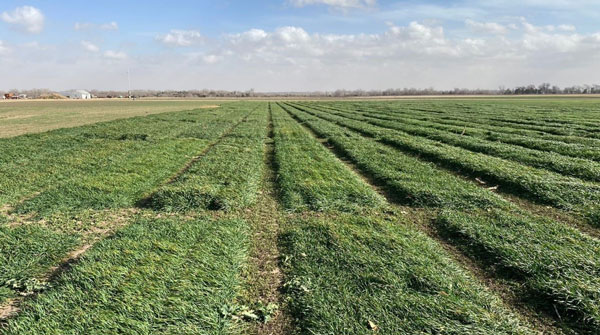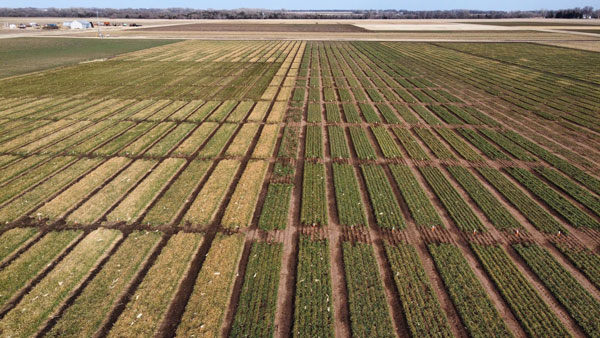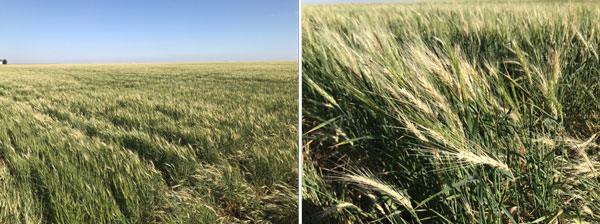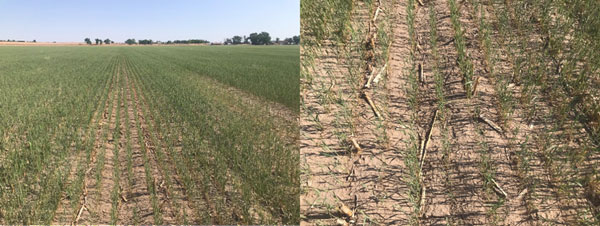Fall growing conditions
The month of September 2021 had an average of 2-3 inches of precipitation across the state of Kansas. In the western part of the state, this precipitation mostly occurred before September 15th. With moisture available, growers in western Kansas planted wheat fields fairly early to ensure good emergence and hopefully decent stand establishment in the fall. However, October was dry in the western portion of the state, with precipitation totals of less than one inch.
Western Kansas was also subjected to the first of several significant wind events on December 15. This caused damage to emerged crops and also removed large amounts of topsoil. Meanwhile, in central and eastern Kansas, October was wet, with above-normal moisture ranging from 2-3 inches. Unfortunately, after October, the entire state began a significant dry stretch that persisted into early 2022. The conditions mentioned above had two main consequences: 1) Fields in central Kansas emerged and established during the fall almost irrespective of planting date (with exception of very late-planted fields), and 2) fields in western Kansas that were planted in mid-October or later did not emerge until the next precipitation event, which did not happen until the spring. Temperatures during the fall were 4-6 degrees warmer than average, increasing the amount of forage biomass produced by early-planted wheat crops when moisture was available (Figure 1).

Figure 1. Large biomass production in a dual-purpose wheat trial near Hutchinson, KS. The trial was sown on 21 September 2021, with 50 lbs DAP/acre applied in furrow and photo was taken mid-December 2021. Weeds were controlled the week prior to sample collection, thus control is still incipient in the photo above. Photo by Romulo Lollato, K-State Research and Extension.
Winter growing conditions
Opposite to the conditions experienced in the fall, temperatures were 1-4 degrees colder than the long-term average during the January 1 – March 31, 2022 period. Dry conditions continued across the state with only east central Kansas observing near-normal rainfall during this period. Average precipitation for the remainder of the state was about an inch below normal, with greatest departures in the southwest. The combination of dry and cool conditions extended the dormant period of the wheat crop. The majority of the varieties evaluated by K-State Research and Extension did not reach the first hollow stem stage of development until March 26 in Hutchinson, which compares to as early as March 6 in years with a warmer winter. Strong winds continued to be an issue with wind erosion and occasional crop damage as a result.
Early spring 2022 growing conditions
The spring started with freezing temperatures during the first two weeks of April, when as many as 11 hours below 32 degrees were accumulated. As the majority of the wheat in central, south central, and southwest Kansas were already going though stem elongation, these freezing temperatures caused low levels of freeze damage to wheat in these regions (Figure 2). The cool and dry conditions experienced during the winter extended until the first week of May, overall delaying the reproductive development of the crop and leading to severe drought stress. In addition to the drought stress, the second week of May was extremely hot, with temperature averages as many as 9-12 degrees above the long-term average for the period in parts of central, south central, and southwest Kansas. This heat stress caused fields to show symptoms of heat scorching in parts of south-central and southwest Kansas (Figure 3).

Figure 2. Leaf damage due to cold winter temperatures in early planted wheat (left) as compared to later planted wheat (right) near Hutchinson, KS. This photo was taken on March 2022, by Romulo Lollato, K-State Research and Extension.

Figure 3. Field in southwest Kansas showing signs of head scorching likely due to heat stress. Photos taken by Romulo Lollato, K-State Research and Extension.
The combination of season-long drought stress and a short period of extreme heat stress in mid-May resulted in several wheat fields in the western portion of the state (west line from Smith to Pratt counties) showing severe symptoms such as younger leaves curled, abortion of older leaves, and yellowing of lower canopy, extremely reduced plant height and biomass, and a delayed development that accelerated through the flowering period due to the heat stress (Figures 4 and 5). Many of the fields across western Kansas were into the reproductive stages of development (flowering and grain elongation) only measuring 9-12 inches tall due to the prolonged stress. From a regional perspective, the worst crop conditions occurred in far southwest Kansas, where season-long drought stress impacted the crop worse than in other regions. However, severely drought-stressed crops occurred as far east as Pratt county. From a cropping systems perspective, the extreme drought caused large differences in the yield potential of the wheat crop as function of previous crop and the presence of a fallow period. In central Kansas, wheat fields planted after a previous wheat or canola crop were showing much better yield potential than wheat fields planted continuously after a soybean crop. These differences were even more apparent in the western portion of the state, where wheat planted after a long-term fallow period may have had a 50-60 bushel per acre yield potential, as compared to a 15-20 bushel per acre yield potential in continuous wheat (3-month fallow), versus a failed crop on wheat after corn (no fallow).

Figure 4. Drought-stressed wheat fields in Norton county, Kansas. Symptoms include decreased crop biomass production and height, curled leaves, abortion of older leaves, and yellowing of lower canopy. Photos taken by Romulo Lollato, K-State Research and Extension.

Figure 5. Drought-stressed wheat fields in Kearney county, Kansas. Symptoms are similar to those in the photos above: decreased crop biomass production and height, curled leaves, abortion of older leaves, and yellowing of lower canopy. Photos taken by Romulo Lollato, K-State Research and Extension.
Grain-filling period
Departure from average precipitation continued below normal in the western portion of the state during the remaining of May and June. Only isolated areas received average rainfall which helped the wheat crop maintain yield potential in these selected locations. In central Kansas, precipitation amounts during the remaining of May and during June were above normal, with areas observing almost double their average moisture. While this may have been excessive and lead to waterlogging in some specific regions of central Kansas, for the most part this precipitation was beneficial and helped the crop during the grain-filling period. These conditions were coupled with below-average temperatures in late May and early June, and slightly above-average temperatures during the entire month of June. Combined, precipitation and temperature regimes after the initial heat stress of mid-May were near ideal for grain yield development, ensuring some grain production despite an already limited yield potential due to the season-long drought stress.
Wheat disease summary
Overall, yield losses to disease were lower than average during the 2021-22 growing season. That being said, there was an above-average amount of wheat streak mosaic virus in central and southwest Kansas (Figure 6). This outbreak could have been partially driven by rainfall in September (leading to an increased amount of volunteer wheat prior to planting) and warmer than average fall temperatures (potentially keeping curl mites active longer). Although many infections likely took place in the fall, symptoms were not apparent in most central Kansas locations until the weather warmed in May.
In addition to wheat streak mosaic virus, barley yellow dwarf virus was also present statewide in moderate levels. Stripe rust remained at trace levels this season in Kansas. Stripe rust was likely suppressed due to low overall regional inoculum (low disease levels in Texas and Oklahoma), unseasonably dry weather through April, and above average temperatures in May. Leaf rust levels also remained trace this season. Fusarium head blight was detectable in eastern Kansas, particularly in fields with corn residue, but levels remained generally low. Common bunt, also known as stinking smut, has emerged for a third season as a problem for many producers after harvest.

Figure 6. Field affected by wheat streak mosaic virus in southcentral Kansas in 2022. This image shows a typical field pattern, where symptoms are most severe at the field margin (where the curl mites migrated in) and improve as you move away from the curl mite source. Photo taken by Kelsey Andersen Onofre, K-State Research and Extension.
Romulo Lollato, Wheat and Forage Agronomist
lollato@ksu.edu
Christopher "Chip" Redmond, Kansas Mesonet Director
christopherredmond@ksu.edu
Kelsey Andersen Onofre, Wheat and Forage Pathologist
andersenk@ksu.edu
Tags: wheat growing season